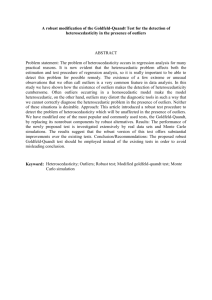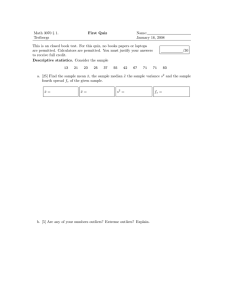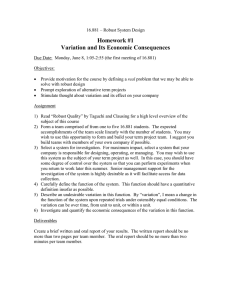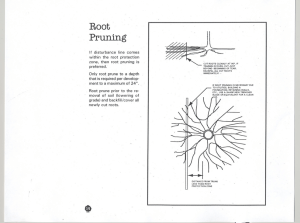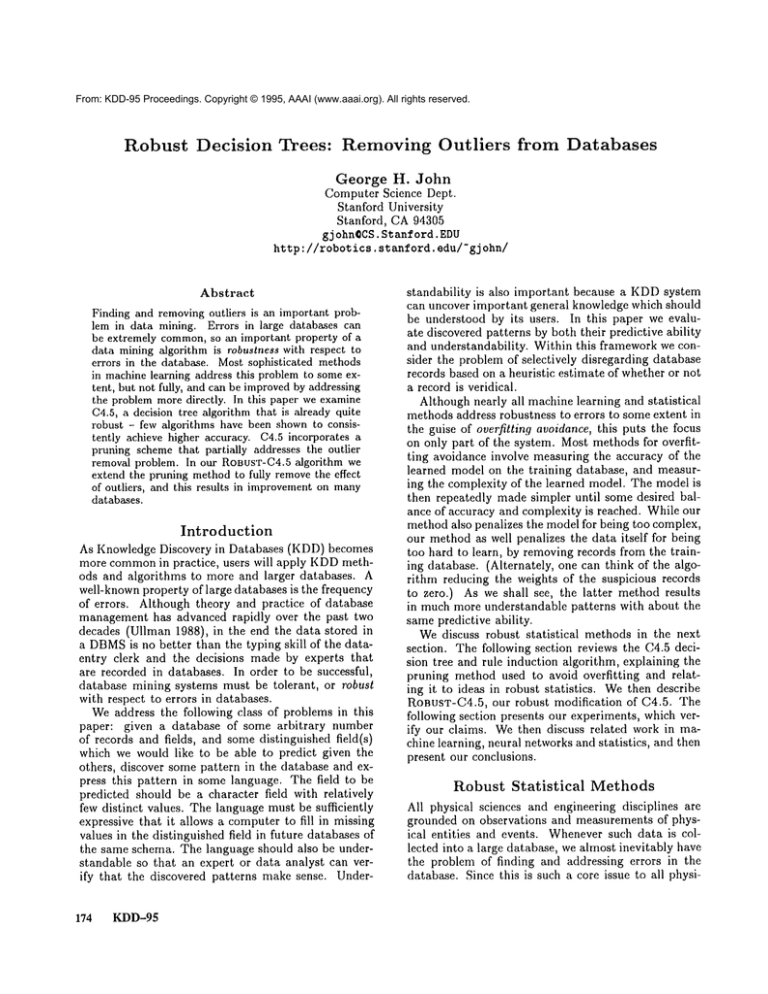
From: KDD-95 Proceedings. Copyright © 1995, AAAI (www.aaai.org). All rights reserved.
Robust
Decision
Trees:
Removing
Outliers
from
Databases
George H. John
Computer Science Dept.
Stanford University
Stanford, CA94305
gj ohn©CS.
Stanford.
EDU
http://robot
ics.stanford,
edu/’gj
ohn/
Abstract
Finding and removingoutliers is an important problem in data mining. Errors in large databases can
be extremely common,so an important property of a
data mining algorithm is robustness with respect to
errors in the database. Most sophisticated methods
in machinelearning address this problemto someextent, but not fully, and can be improvedby addressing
the problem more directly. In this paper we examine
C4.5, a decision tree algorithm that is already quite
robust - few algorithms have been shownto consistently achieve higher accuracy. C4.5 incorporates a
pruning schemethat partially addresses the outfier
removal problem. In our ROBUST-C4.5
algorithm we
extend the pruning methodto fully removethe effect
of outliers, and this results in improvementon many
databases.
Introduction
As Knowledge Discovery in Databases (KDD) becomes
more commonin practice, users will apply KDDmethods and algorithms to more and larger databases. A
well-knownproperty of large databases is the frequency
of errors. Although theory and practice of database
management has advanced rapidly over the past two
decades (Ullman 1988), in the end the data stored
a DBMS
is no better than the typing skill of the dataentry clerk and the decisions made by experts that
are recorded in databases. In order to be successful,
database mining systems must be tolerant, or robust
with respect to errors in databases.
Weaddress the following class of problems in this
paper: given a database of some arbitrary number
of records and fields, and somedistinguished field(s)
which we would like to be able to predict given the
others, discover some pattern in the database and express this pattern in some language. The field to be
predicted should be a character field with relatively
few distinct values. The language must be sufficiently
expressive that it allows a computerto fill in missing
values in the distinguished field in future databases of
the same schema. The language should also be understandable so that an expert or data analyst can verify that the discovered patterns make sense. Under174
KDD-95
standability is also important because a KDDsystem
can uncover important general knowledge which should
be understood by its users. In this paper we evaluate discovered patterns by both their predictive ability
and understandability. Within this frameworkwe consider the problem of selectively disregarding database
records based on a heuristic estimate of whether or not
a record is veridical.
Althoughnearly all machinelearning and statistical
methodsaddress robustness to errors to someextent in
the guise of overfitting avoidance, this puts the focus
on only part of the system. Most methods for overfitting avoidance involve measuring the accuracy of the
learned model on the training database, and measuring the complexity of the learned model. The model is
then repeatedly made simpler until some desired balance of accuracy and complexity is reached. While our
methodalso penalizes the model for being too complex,
our methodas well penalizes the data itself for being
too hard to learn, by removing records from the training database. (Alternately, one can think of the algorithm reducing the weights of the suspicious records
to zero.) As we shall see, the latter method results
in much more understandable patterns with about the
same predictive ability.
Wediscuss robust statistical
methods in the next
section. The following section reviews the C4.5 decision tree and rule induction algorithm, explaining the
pruning method used to avoid overfitting and relating it to ideas in robust statistics.
Wethen describe
RoBuST-C4.5, our robust modification of C4.5. The
following section presents our experiments, which verify our claims. Wethen discuss related work in machine learning, neural networks and statistics, and then
present our conclusions.
Robust Statistical
Methods
All physical sciences and engineering disciplines are
grounded on observations and measurements of physical entities and events. Wheneversuch data is collected into a large database, we almost inevitably have
the problem of finding and addressing errors in the
database. Since this is such a core issue to all physi-
Least Squares
................
L1
......
Least Trimmed Squares
ou
¢n
o
.__.to
(DO
¢--O
o,-
._o
50
55
60
Year
65
70
Figure 1: Millions of phone calls in Belgium, 1950-1973, from Rousseeuw&Leroy (1987). Plotted in S-PLUSusing
code from Venables ~z Ripley (1994).
cal sciences and engineering disciplines, one might expect that scientists and statisticians have considered
the problem for some time. In 1777 while studying
astronomical data, Daniel Bernoulli wrote "I see no
way of drawing a dividing line between those that are
to be utterly rejected and those that are to be wholly
retained; it mayeven happen that the rejected observation is the one that would have supplied the best
correction to the others..." (Barnett &Lewis 1993, p.
27).
In statistics,
an outlier is defined as a "case that
does not follow the same modelas the rest of the data"
(Weisberg 1985). This is broad, including not only erroneous data but also "surprising" veridical data. Most
of the work addressing outliers in statistics assumeseither a simple estimation task, such as estimating the
mean and covariance matrix of a normal distribution,
or a linear regression. Such statistical
methods are
called robust, since the estimators can withstand (are
only minimally effected by) outliers in data. Wewill
present a high level overview of work on outliers, and
then discuss howthey relate to robust decision trees.
Figure 1 shows a database of phone calls made in
Belgium. Except for the six years from 1964 - 1969
it’s a pretty dull dataset. The six outliers were caused
by a mistake in recording the data - during the six
year period the total number of minutes spent on the
phone was recorded rather than the total number of
calls. Wecan see that the effect of the outliers on linear
regression is disastrous. Linear regression attempts to
fit a line to a set of points so as to minimizethe sumsquared residuals (errors):
-
,
P
where p indexes each training point, and ~)p indicates
the value at xp predicted by the linear model. A simple algebraic procedure finds the line minimizing this
criterion. Outliers are especially problematic because
of the squared error objective function.
There are two main ways that statisticians
have
addressed the outlier problem: accommodation and
identification/rejection.
We’ll first discuss an example of the accommodationmethod, then the rejection
method. Figure 1 shows the result of "LI" regression, which is just like least squares regression except
that the objective function is changedto ~p lYp - ~)pl,
which de-emphasizes points far away from the fitted line. The accommodation methods, due to Hubet (1981), involve modifying the objective function
(usually sum-squared error) to down-weight the effect of outliers. Huber’s proposal was the M-estimate:
~p p(yp - ~p)/Cr, where p is some function and ~r is
an unimportant constant scale factor. Whenp is the
absolute value function we get L1 regression.
Rather than defining an objective function that
lessens the impact of outliers while still allowing them
to influence the fitted model, we may instead simply
try to identify outliers directly and removethem from
consideration. Another way to say this is that we may
John
175
restrict our attention only to those training records
that seem "normal." The least trimmed squares (LTS)
method of Rousseeuw ~ Leroy (1987) uses this idea
rather than minimizing the sum of squared errors, it
instead finds the line with minimal trimmed sum of
squared errors, which corresponds to minimizing the
errors on those points that seem most normal. (When
a set of numbers is trimmed, the highest and lowest
few numbers are removed.) Figure 1 shows that the
LTSregression fit the veridical data best.
Another approach to identification
is not through
the residuals on each training record but rather on a
measureof the effect a record has on the learned model.
Points with high leverage, points with disproportionately high effect on the fitted model, are identified and
removed from training data in order to better fit the
remaining points.
Commonly,outliers are thought of as shown in Figure t - points that are far away from the rest of the
data, but this needn’t be the case. In a classification
task, for example, a point of class A might be an outlier if found in the middle of a dense cluster of points
from class B. The identification of outliers in categorical (nominal, unordered) data has not been addressed
in statistics. It is this problemofoutliers in categorical
data that the present paper addresses. The only idea
that seems to be easily portable from linear regression
to classification trees (or decision trees) is the idea
leverage - we will next explore this idea in the context
of C4.5.
C4.5 and Pruning:
Model Selection
C4.5 (Quinlan 1993) is a decision tree induction program. A decision tree predicts unknownfield values
by asking a series of yes/no or multiple-outcome questions. Each question is of the form "Is the value of
field f equal to k?" or "Is the value of field f less
than x." Each question in tile series is chosen based
on tile answers to previous questions. After somenumber of questions have been answered, the value of the
unknownfield is predicted.
One problem with decision trees (and with all nonparametric statistical
methods and learning methods)
is that they can simply memorize a database given
to them as training data. Generally, memorizing the
database is not a useful activity (we have the database
already!) so instead we want to try to learn patterns
that generalize well to future data. Endeavorsto solve
this problem usually rely on the application of Occam’s
razor, which can be paraphrased as "keep it simple."
I.E., if several decision trees are roughly consistent
with a database, we should choose the simplest one
if we hope to generalize well. There are also statistical
arguments phrasing this as the bias-variance problem
(Breiman, Friedman, Olshen & Stone 1984, Geman,
Bienenstoek & Doursat 1992), but we will not pursue
this further.
After inducing a decision tree from a database we
176
KDD-95
Table 1: The ROBUST-C4.5
algorithm repeatedly runs
C4.5 and removes those records it misclassifies from
the training database until all records in the reduced
training set are correctly classified.
ROBUSTC45(TrainingData)
repeat{
T <- C45BuildTree(TrainingData)
T <- C45PruneTree(T)
foreachecord in TrainingData
if T misclassifiesRecordthen
remove Recordfrom TrainingData
} until T correctlyclassifiesall
Recordsin TrainingData
often are left with a complextree that fits our training
database well. Wethen prune it to make it simpler.
This usually causes it to perform more poorly on the
training data, but better on data held out as a test
sample. Given a complex decision tree with n nodes,
we need some procedure for choosing one of the many
subtrees that we may arrive at by pruning. C4.5’s
procedure for this involves repeatedly asking "should
this node be made into a leaf?" at each node. The
question is answered by estimating the error of the
node given the current tree, then estimating the error if
the node were pruned to a leaf. If the resulting error is
smaller, the node is pruned. After repeatedly pruning
or not pruning nodes we are left with the final tree.
C4.5’s error estimation methodimplicitly weighs the
numberof records that wouldbe misclassified if a given
current node were pruned against the reduction in tree
size resulting from pruning the node. If only a few
points will be misclassified, but manynodes can be
saved, C4.5 will prune the node. Thus, after pruning,
the set of records misclassified by C4.5’s tree will approximate the set of points with high leverage - those
few points which caused a large tree structure to be
created so that they wouldbe classified correctly.
Robust
C4.5:
Data
Selection
Pruning is a method of local data selection, since
records are effectively removedfrom nodes deep in the
tree - pruning a node to a leaf has the same effect as
removing all instances that were not in the majority
class in the subset of the database used to build that
node’s subtree. This begs the question: if the records
are locally un-informative or harmful, then whyshould
we suspect that they helped the algorithm to discover
patterns higher in the tree - that is, more globally?
Wecould think of no good answer to this question, and
so developed the ROBUST-C4.5
algorithm described in
Table 1.
A novelty in our robust approach is to rebuild the
tree using the reduced training set. The reduced training set is defined to the original training set minus the
/
®
-I-
Figure 2: Leverage in a decision tree: the two points
caused the subtree to be built. Whenthey are removed,the tree size shrinks by 8 nodes.
instances which the pruned tree now classifies incorrectly (the "confusing" instances). While retraining
may seem odd, it is in fact just an extension of the
assumptions underlying pruning. By pruning the tree
we essentially assume that these confusing instances
are locally not useful. Retraining merely takes this assumption a step further by completely removing these
instances from the training set. This makes explicit
the assumption that locally un-informative or harmful
records are globally un-informative as well. The regularization algorithm continues pruning and retraining
until no further pruning can be done. Though common
in regression in the guise of robust (Huber 1977) or resistant (Hastie & Tibshirani 1990, Chapter 9) fitting,
in the context of classification this appears to be novel.
Relating this to the previous discussion on robust
statistics, in the context of decision trees we mayidentify a set of points with high leverage by examining
the difference in numberof nodes between a tree built
with and without the set of points (Figure 2). This difference is estimated by starting with a pure tree built
using all the points and then pruning. The training
instances that it nowclassifies incorrectly are the high
leverage points that were removed. However, the removal of the points by pruning was only approximate-the obvious step is to removethe points from the training set and retrain.
Experiments
Because of the arguments above, we hypothesized that
ROBUST-C4.5would be a worthy competitor to C4.5
always resulting in smaller trees and increasing accuracy on domains with many outliers. Also, since the
definition of a robust statistic requires small changesin
the statistic for small changes in the data, the standard
deviation of the accuracy of ROBUST-C4.5
should be
smaller than C4.5. Belowwe first describe the experimental methodology and then present and discuss the
results.
Method
To test the hypotheses, we compared ROBUST-C4.5
and C4.5 on 21 databases selected from the UCI
and Statlog database repositories
(Murphy g~ Aha
1994, Michie, Spiegelhalter
86 Taylor 1994). The
databases are all stored and processed as a single relation (table). The databases were selected with
particular agenda in mind other than convenience. To
compare ROBUST-C4.5and C4.5 on a given database
we used ten-fold cross-validation. At a computational
expense, this methodgives one a more reliable estimate
of the accuracy of a learning algorithm than a single
run on a held-out test set. Cross-validation involves
randomly partitioning the database into ten disjoint
databases, then providing each algorithm with nine as
training data and using the remaining as test cases.
This process is repeated ten times using the different
possible test sets.
For purposes of testing the hypotheses, the important statistics to gather for each run of each algorithm
on each database are: the mean of the accuracies from
the ten runs, the meanof the tree sizes, and the standard deviation of the accuracy among the ten crossvalidation runs.
Results
Table 2 presents the results from the experiments described above. For each dataset and algorithm, we
report the average of the ten cross-validation accuracies, their standard deviation, and the average of the
ten tree sizes. At the bottom, each column’s average
is reported.
There are several interesting things to point out in
the table. Note that ROBUST-C4.5’s
average accuracy
is slightly higher than C4.5, which weakly verifies our
assumption that Rol3osw-C4.5 will have higher accuracy than C4.5. Note that since ROBUST-C4.5specializes in the removal of outliers, it might perform
badly on complex datasets where there is no noise,
but some patterns are under-represented. In such settings we might expect ROBUST-C4.5to degrade performance by throwing out perfectly good data (the
problem that worried Bernoulli over two hundred years
ago), and this was the case. Using a paired t test, we
found that the accuracies of P~OBUST-C4.5
and C4.5
were statistically indistinguishable (at the 95%level)
on all datasets but four. ROBUST-C4.5
performed better than C4.5 on "labor-neg" (Canadian labor negotiation), and worse on Tic-Tac-Toe and "segment" (an
image segmentation problem). Although we cannot
make any statements about the probability of human
error in manually classifying the image segments for
the "segment" database, the Tic-Tac-Toe database is
noise-free and fairly difficult for decision trees to learn
(note the average tree size of 133), so it fits our "hardbut-error-free" profile perfectly.
Another interesting pattern in the data is the average tree size. ROBUST-C4.5manages to produce
John
177
Table 2: Accuracies for C4.5 and RC4.5 on several
Accuracy Mean Accuracy StdDev
Dataset
C4.5 RC4.5 C4.5
RC4.5
85.53
australian
85.81
3.8
3.8
breast-cancer
74.49
74.13
5.2
5.3
breast
94.42
94.28
2.8
2.7
chess
99.45
99.45
0.4
0.4
cleve
73.54
74.54
7.1
6.5
84.80
85.10
4.5
crx
4.7
diabetes
72.76
74.71
6.1
5.9
german
73.10
75.10
3.6
3.6
glass
67.78
70.10 10.8
10.2
heart
74.10
73.36 10.5
6.0
hepatitis
76.20
77.95
7.6
6.6
horse-colic
84.51
85.59
4.7
4.5
hypothyroid
99.10
99.50
0.7
0.6
iris
94.66
92.67
5.3
7.3
labor-neg
77.68
84.67
1-7.5
14.7
lymphography
76.91
75.57
tl.3
10.9
segment
96.35
95.87
1.3
0.8
sick-euthyroid
97.67
97.60
0.8
0.9
tic-tac-toe
86.23
83.20
4.6
4.4
vote
94.73
94.73
2.1
2.1
votel
88.71
88.71
5.9
5.9
AVERAGE
84.42
84.88
5.5
5.1
trees that are 29%smaller than C4.5’s trees, while
maintaining the same level of accuracy. In manycases
ROBUST-C4.5can dramatically reduce tree size -note the "diabetes" (Pima Indian diabetes) and "german" (accept/reject loan applications) datasets, where
tree size was reduced by 70%and 79% respectively.
The "german" dataset probably resembles most closely
the types of tasks commonin KDD:given features such
as salary, savings, type of loan and other personal information, predict whether the loan should be granted
or denied. Since one of the goals of KDDis to present
understandable patterns to a data analyst, ROBUSTC4.5 should be a worthwhile additional tool.
Regarding the robustness of ROBUST-C4.5note
that the average standard deviation is indeed smaller
than C4.5 by about .4. Looking at each database, the
standard deviation of RoBUST-C4.5was smaller than
C4.5 on eleven, the same on six, and higher on four.
This supports the last hypothesis and indicates that
by removing outliers, the ROBUST-C4.5
algorithm is
able to learn more stable representations of the hidden
patterns in the data than C4.5.
Hastie (1994) suggested that the success of ROBUSTC4.5 was simply due to the fact that C4.5 does not
prune enough, therefore the advantage from ROBUSTC4.5 is simply due to the fact that after rebuilding the
tree, the pruning algorithm gets another shot at reducing the size further. To test this we ran two other full
experiments like the one reported above with different
settings for C4.5’s pruning parameter, and found qual178 KDD--95
databases.
Tree Size
C4.5 RC4.5
48.1
32.9
10.8
11.5
20.2
12.6
55.0
55.0
43.5
28.4
53.3
32.6
127.8
38.0
149.6
30.8
51.6
37.8
35.8
21.8
15.4
10.4
18.4
16.2
15.0
9.6
7.2
7.2
5.9
5.6
26.6
20.1
79.8
71.6
30.0
23.8
133.0
109
14.5
14.5
28.6
26.8
46.2
32.9
itatively the sameresults as in our original experiment.
Thus the superior performance of ROBUST-C4.5does
not seem to be due solely to under-pruning on C4.5’s
part.
Related
Work
I~OBUST-C4.5is based on our earlier work in decision trees (John 1995), whichalso rejected misclassified
records and retrained. Regarding robust methods and
outlier rejection, Huber (1977) states "I am inclined
to ... prefer technical expertise to any ’statistical’ criterion for straight outlier rejection." Weare guilty
of this sin in our work, but Guyon, Boser & Vapnik
(1993) have proposed an interesting methodfor making
use of humanexpertise in outlier removal to "clean" a
dataset. Similarly, rather than rejecting suspected outliers outright, RoBusT-C4.5could as well interview an
expert, presenting the suspicious database records and
asking for an opinion as to whether the record should
be removed or down-weighted. Barnett & Lewis (1993)
give an interesting and entertaining survey of work in
outlier removal in statistics. Venables &Ripley (1994,
ch. 8) present a concise review of robust statistics,
accompanied by S-PLUS code.
Another way of looking at robust methods (and the
identification approach in particular) is as a data selection method. The selection of data for training is an
ubiquitous problem in KDD. Many methods are passive, accepting data from a training sample in some
random order or all at once as a set. Other methods
(Aha 1991) actively accept or reject training patterns
from a temporal sequence presented to them. The difference between outlier removal and active learning (as
commonlypresented) is somewhat akin to the difference between forward and backward feature subset selection (John, Kohavi ~ Pfleger 1994) or forward and
backward (construction/pruning)
search methods over
neural net or decision tree architectures. In general,
unless time is a very limited resource, the best results are achieved by starting "big" and then shrinking
(Breimanet al. 1984). This should apply to pattern selection as well, and thus we suspect backward pattern
selection (i.e., outlier removal)will give greater performance than forward selection. Cohn (1994) discusses
yet more "active" data selection methods that might
perform even better, but they require the availability
of a domain expert.
Since RoBusT-C4.5 just runs C4.5 many times on
similar databases, the approach could benefit from an
incremental tree-updating scheme such as that proposed in Utgoff (1994) - rather than removing the
outliers from the database and retraining on the entire remainder, we could instead simply incrementally
remove the outliers from the tree itself, never having
to fully retrain.
Conclusion
Wehave presented a learning algorithm based on ideas
drawn from robust statistics.
Rather than solely being concerned with the structure, complexity and accuracy of the patterns it has learned from the database,
our methodalso actively screens the training database
in an attempt to ignore erroneous records. Such robust methods seem well-suited to learning patterns in
databases which are likely to have many errors - by
ignoring the errors the produced patterns can be more
accurate and far simpler than patterns produced by
comparable algorithms which are forced to pay attention to all records. Our experiments on 21 databases
confirm this claim, showingthat on datasets with characteristics
typical of KDDtasks, our RobusT-C4.5
can learn trees with slightly higher accuracy and up
to 70%fewer nodes C4.5’s trees.
Acknowledgements
This research was supported under an NSF Graduate
Research Fellowship. We would like to thank Jerry
Friedman, Nils Nilsson and Pat Langley for helpful discussions.
References
Aha, D. W. (1991), "Instance-based learning
rithms", Machine Learning 6(1), 37-66.
algo-
Barnett, V. ~ Lewis, T. (1993), Outliers in Statistical Data, third edition, John Wiley 8z Sons, New
York.
Breiman, L., Friedman, J., Olshen, R. &: Stone,
C. (1984), Classification and Regression Trees,
Chapman&: Hall, New York.
Cohn, D. (1994), "Improving generalization with active learning", MachineLearning 15(2), 201-221.
Geman, S., Bienenstock,
E. & Doursat,
R.
(1992), "Neural networks and the bias/variance
dilemma", Neural Computation 4, 1-58.
Guyon, I., Boser, B. & Vapnik, V. (1993), Automatic
capacity tuning of very large VC-dimensionclassitiers, in S. J. Hanson,J. Cowan~ C. L. Giles, eds,
"Advances in Neural Information Processing Systems", Vol. 5, Morgan Kaufmann, pp. 147-154.
Hastie, T. (1994), Personal Communication.
Hastie, T. J. &Tibshirani, R. J. (1990), Generalized
Additive Models, Chapmanand Hall.
Hirsh, H. &: Cohen, W., eds (1994), MachineLearning:
Proceedings of the Eleventh International Conference, Morgan Kaufmann.
Huber, P. (1981), Robust Statistics, Wiley, NewYork.
Huber, P. J. (1977), Robust Statistical Procedures, Society for Industrial and Applied Mathematics,
Pittsburgh, PA.
John, G. H. (1995), Robust linear discriminant trees,
in "Fifth International Workshopon Artificial Intelligence and Statistics",
Ft. Lauderdale, FL,
pp. 285-291.
John, G., Kohavi, R. ~ Pfleger, K. (1994), Irrelevant features and the subset selection problem,
in Hirsh & Cohen (1994), pp. 121-129.
Michie, D., Spiegelhalter, D. J. & Taylor, C. C. (1994),
Machine Learning, Neural and Statistical Classification, Prentice Hall.
Murphy, P. M. & Aha, D. W. (1994), "UCI repository of machine learning databases", Available by anonymous ftp to ics.uci.edu
in the
pub/machine-learning-databases
directory.
Quinlan, J. R. (1993), C4.5: Programs for Machine
Learning, Morgan Kaufmann.
Rousseeuw, P. J. & Leroy, A. M. (1987), Robust Regression and Outlier Detection, John Wiley and
Sons, NewYork.
Ullman, J. D. (1988), Principles of Database and
Knowledge-Base Systems: Volume 1: Classical
Database Systems, Addison-Wesley.
Utgoff, P. (1994), An improved algorithm for incremental induction of decision trees, in Hirsh & Cohen
(1994), pp. 318-326.
Venables, W. N. 8~ Ripley, B. D. (1994), Modern Applied Statistics with S-Plus, Springer-Verlag, New
York.
Weisberg, S. (1985), Applied Linear Regression, John
Wiley ~ Sons.
John
179

![[#GEOD-114] Triaxus univariate spatial outlier detection](http://s3.studylib.net/store/data/007657280_2-99dcc0097f6cacf303cbcdee7f6efdd2-300x300.png)
